Fast Growing Radishes to Plant in July UK: Your Complete Summer Growing Guide
July is perfect for planting fast-growing radishes in the UK! Discover the quickest varieties, expert growing tips, and how to harvest crunchy radishes in just 3-4 weeks during summer heat.
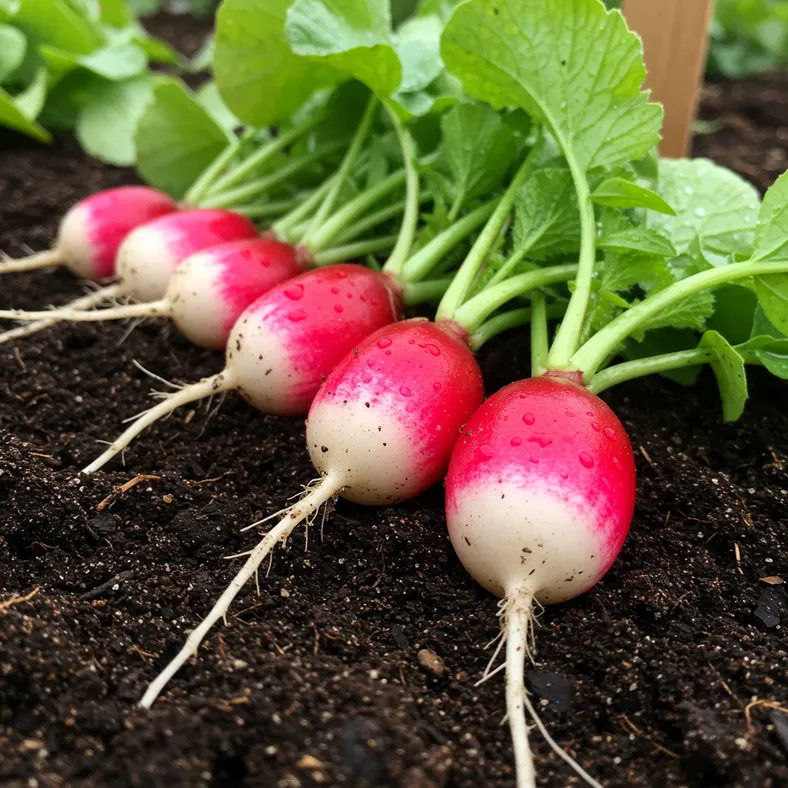
- Why July is Perfect for Fast-Growing Radishes
- Best Fast-Growing Radish Varieties for July Planting
- Optimal Sowing Techniques for July Success
- Managing Heat and Moisture During July
- Rapid Growth Care and Maintenance
- Harvesting Your July-Sown Radishes
- Troubleshooting Common July Growing Issues
- Companion Planting and Succession Strategies
July presents the perfect opportunity for UK gardeners to plant fast-growing radishes that will provide a crunchy, peppery harvest in just 3-4 weeks. While many vegetables struggle in summer heat, certain radish varieties actually thrive in July's warm conditions, making them ideal for quick succession planting and continuous harvests throughout late summer.
This comprehensive guide reveals the fastest-growing radish varieties specifically suited to July planting in the UK, along with expert techniques to ensure your summer radish crop develops properly despite the warmer temperatures. Whether you're filling gaps in your vegetable plot or starting fresh sowings, these quick-growing radishes will reward you with crisp, flavourful roots before the autumn arrives.
Why July is Perfect for Fast-Growing Radishes
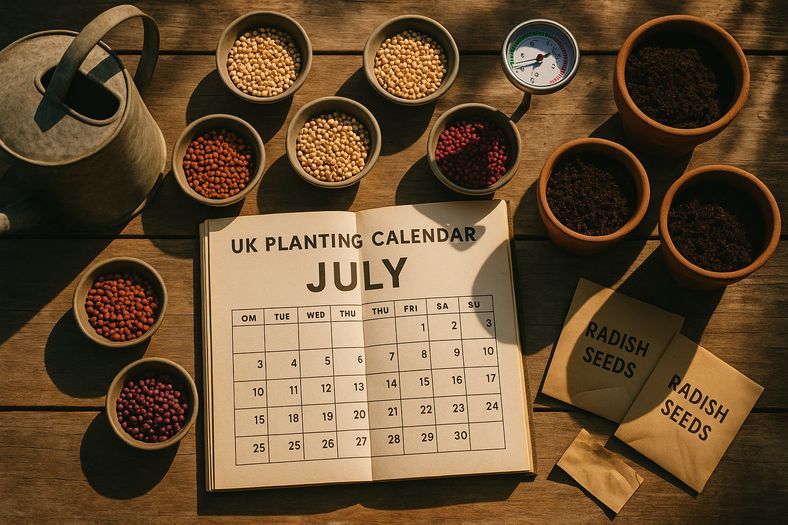
July offers unique advantages for growing radishes in the UK, despite the summer heat. The long daylight hours and warm soil temperatures create ideal conditions for rapid germination and growth when you choose the right varieties and techniques.
Fast-growing radishes planted in July benefit from:
- Warm soil temperatures - July's soil warmth accelerates germination from 10 days to just 5-7 days
- Extended daylight hours - Up to 16 hours of daylight fuel rapid photosynthesis and growth
- Consistent moisture - Summer rainfall patterns, when managed properly, support steady development
- Less pest pressure - Many spring pests have completed their life cycles, reducing damage
- Perfect timing - Harvest coincides with late summer salad season and autumn meal preparation
The key to July success lies in selecting heat-tolerant, quick-maturing varieties and providing adequate moisture and partial shade during the hottest parts of the day. With proper variety selection, you can achieve harvests in as little as 20-25 days from sowing.
Best Fast-Growing Radish Varieties for July Planting
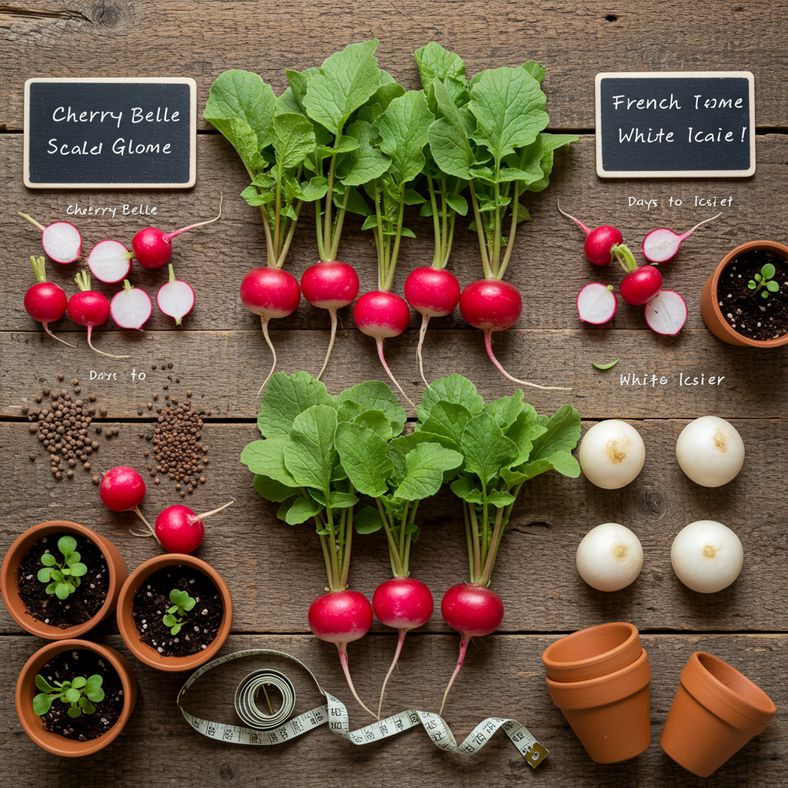
Selecting the right varieties is crucial for July success. These heat-tolerant, quick-maturing radishes have been proven to perform exceptionally well in UK summer conditions:
Cherry Belle (18-25 days)
The ultimate speed champion for July planting. Cherry Belle produces perfectly round, bright red radishes with crisp white flesh in just 18-25 days. This variety handles heat stress better than most and maintains its mild, crisp texture even in warm weather.
Scarlet Globe (20-25 days)
An RHS Award of Garden Merit winner that excels in summer heat. Scarlet Globe develops uniform, globe-shaped roots with vibrant red skin and snow-white interior. The mild flavour when young makes it perfect for salads and garnishes.
French Breakfast (22-28 days)
This distinctive cylindrical variety with its red body and white tip adds visual appeal to summer salads. French Breakfast maintains its crisp texture and mild peppery flavour even when grown in July's warmth, making it ideal for continuous harvesting.
White Icicle (25-30 days)
A heat-tolerant, elongated white radish that stays crisp and mild-flavoured throughout summer. White Icicle's unique shape and colour provide excellent contrast in mixed salads and its slow-bolting nature makes it perfect for July sowings.
Easter Egg Mix (20-25 days)
This colourful blend includes purple, red, pink, and white varieties, all selected for rapid growth and heat tolerance. The mix provides continuous interest and varying flavours, perfect for summer succession planting.
For those seeking organic options, consider these quality radish seeds that provide excellent germination rates and heat tolerance.
Optimal Sowing Techniques for July Success
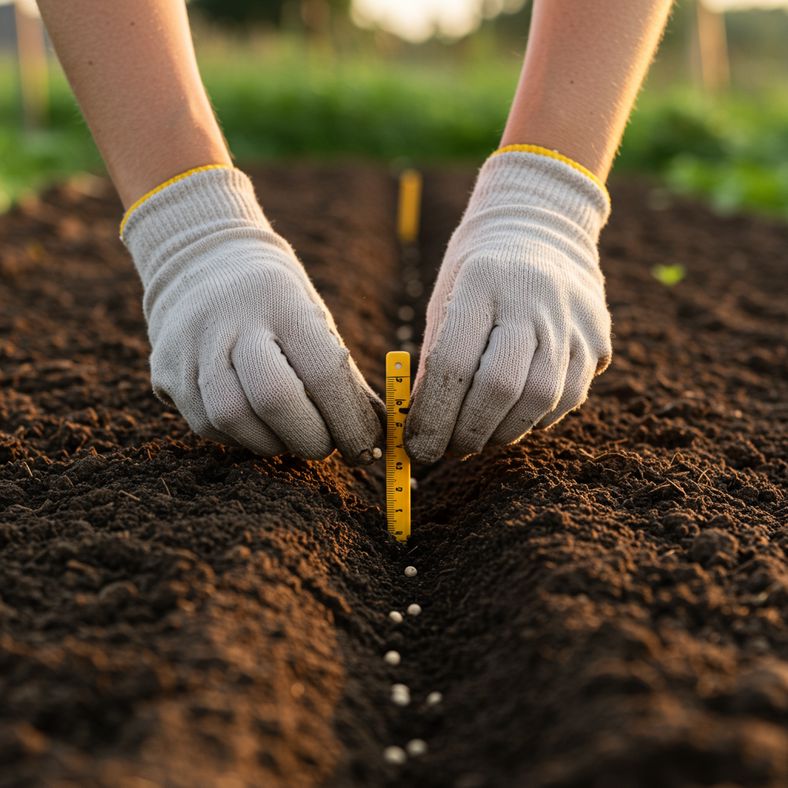
July's warm conditions require modified sowing techniques to ensure successful germination and healthy growth. Follow these expert methods for optimal results:
Site Selection and Preparation
Choose a location that receives morning sun but has some protection from intense afternoon heat. A spot that gets 4-6 hours of direct sunlight is ideal, with natural or artificial shade during the hottest part of the day (12-3 PM).
Prepare the soil by:
- Working in 2-3cm of well-rotted compost to improve moisture retention
- Ensuring soil pH is between 6.0-7.0 for optimal nutrient uptake
- Removing any stones or debris that could impede root development
- Creating a fine, level seed bed with a rake
- Watering the area thoroughly before sowing if soil is dry
Sowing Methods
Direct Sowing in Rows: Create shallow drills 1cm deep, spaced 15cm apart. Sow seeds 2-3cm apart within the row, which allows for natural thinning and reduces competition.
Broadcast Sowing: For quick succession crops, scatter seeds thinly across prepared soil and rake gently to cover. This method works well for cut-and-come-again harvesting.
Container Growing: Use containers at least 20cm deep filled with quality multi-purpose compost. This method provides better moisture control and allows for easy relocation to shadier spots during heat waves.
Timing Your Sowings
For continuous harvests throughout late summer and early autumn, sow small amounts every 10-14 days from early July through August. This succession planting ensures a steady supply of fresh radishes rather than a single large harvest.
Early July sowings (1st-10th) are ideal for varieties like Cherry Belle and Scarlet Globe, while mid-July sowings (11th-20th) work well for French Breakfast and White Icicle varieties.
Managing Heat and Moisture During July
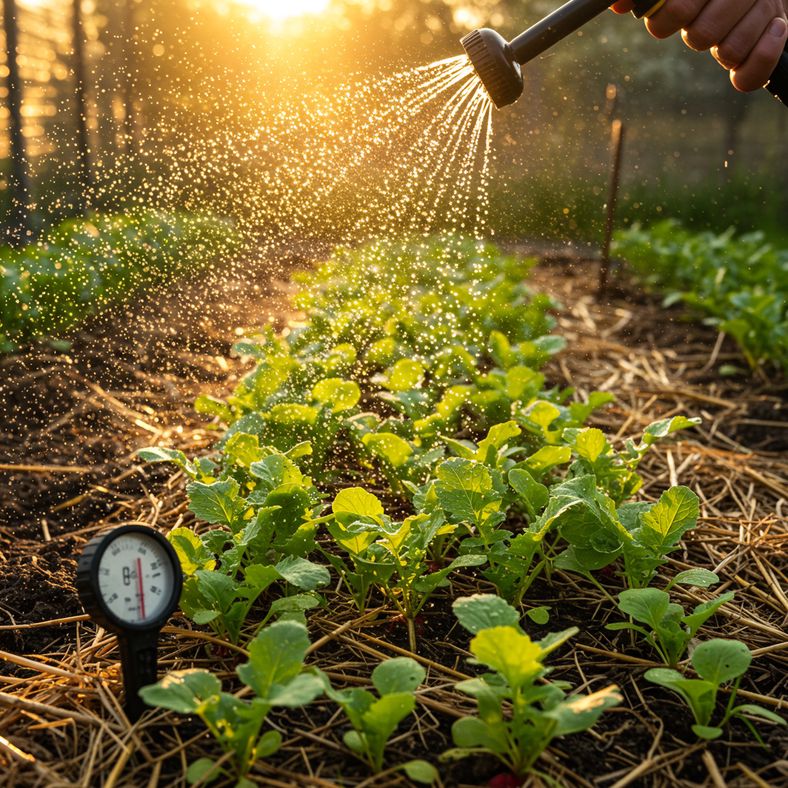
July's heat and potential drought conditions require careful water management and temperature control to ensure your radishes develop properly without bolting or becoming woody.
Watering Strategies
Consistent moisture is crucial for rapid, even growth. July-sown radishes need approximately 2.5cm of water per week, delivered through a combination of rainfall and irrigation.
Morning Watering: Water deeply in the early morning (6-8 AM) to allow plants to absorb moisture before heat stress begins. This timing also reduces disease risk and water evaporation.
Mulching: Apply a 2-3cm layer of organic mulch around plants to retain soil moisture, regulate temperature, and suppress weeds. Grass clippings, straw, or composted leaves work excellently.
Consistent Scheduling: Water every 2-3 days during dry spells, providing a thorough soaking rather than frequent light watering. This encourages deep root development and reduces stress.
Temperature Management
Protect your July radishes from extreme heat using these techniques:
- Shade Cloth: Install 30-50% shade cloth over beds during heat waves (temperatures above 25°C)
- Companion Planting: Plant radishes near taller crops like lettuce or spinach that can provide natural shade
- Row Covers: Use lightweight horticultural fleece during the hottest part of the day, removing it in the evening for air circulation
- Container Mobility: Move container-grown radishes to shadier locations during extreme heat
Monitor soil temperature with a thermometer – radishes prefer soil temperatures between 15-20°C for optimal growth. If soil exceeds 25°C, increase watering frequency and provide additional shade.
Preventing Bolting
July's heat can cause radishes to bolt (flower prematurely), making roots inedible. Prevent this by:
- Choosing bolt-resistant varieties
- Maintaining consistent soil moisture
- Providing afternoon shade
- Harvesting promptly when roots reach maturity
- Avoiding high-nitrogen fertilizers which encourage leafy growth over root development
Rapid Growth Care and Maintenance
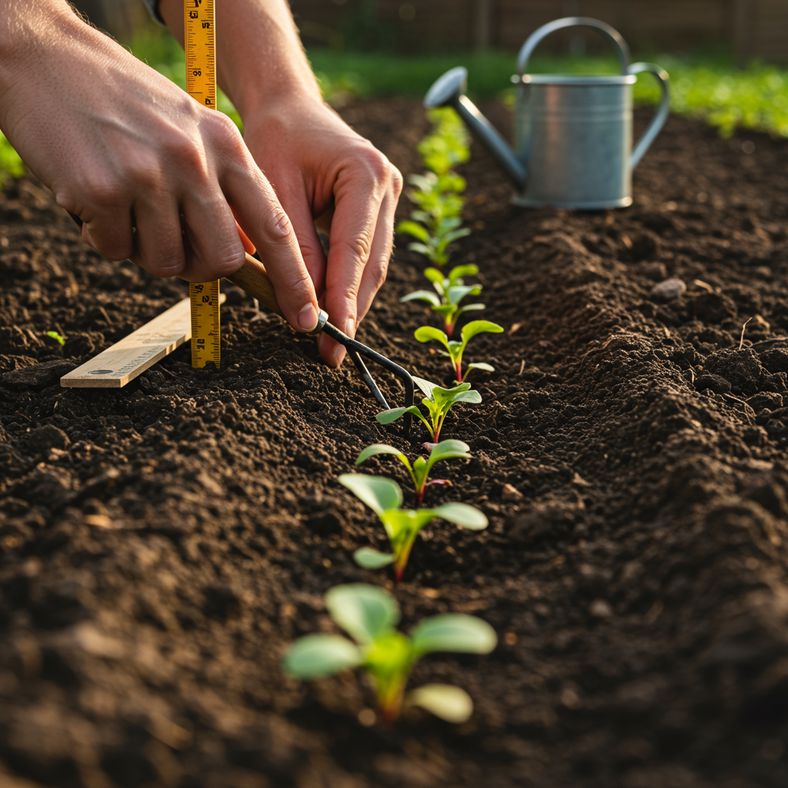
Fast-growing radishes require minimal but focused care during their short growing period. Proper maintenance ensures maximum growth rates and the highest quality harvest.
Fertilizing for Speed
July radishes need a balanced approach to nutrition that promotes rapid root development without encouraging excessive leaf growth:
- Pre-sowing: Work a balanced 10-10-10 fertilizer into the soil at 50g per square meter before sowing
- Side-dressing: Apply a light application of liquid fertilizer when seedlings are 5cm tall, focusing on phosphorus for root development
- Avoid over-fertilizing: Excess nitrogen causes all leaf and no root – use fertilizers sparingly
For organic growers, well-rotted compost worked into the soil provides adequate nutrition for the short growing period.
Thinning and Spacing
Proper spacing is crucial for rapid root development. When seedlings are 2-3cm tall (usually 7-10 days after sowing):
- Thin to 3-4cm apart for small globe varieties
- Space cylindrical varieties 4-5cm apart
- Remove the weakest seedlings, leaving the strongest plants
- Use thinned seedlings as microgreens in salads
Weed Management
Fast-growing radishes can't compete with weeds during their rapid development phase. Maintain weed-free conditions by:
- Hand-weeding close to plants to avoid root damage
- Using a hoe between rows for larger weeds
- Applying mulch to suppress weed germination
- Staying vigilant – a week of weed growth can significantly impact harvest quality
Quality tools make maintenance easier. These professional garden secateurs are perfect for precise thinning and harvesting work.
Monitoring Growth Progress
Track your radishes' development to ensure optimal harvest timing:
- Week 1: Germination and first true leaves
- Week 2: Rapid leaf development and root initiation
- Week 3: Root swelling becomes visible at soil surface
- Week 4: Harvest time for most varieties
Check plants daily after week 2 – July's heat can accelerate growth, and timing is crucial for quality.
Harvesting Your July-Sown Radishes
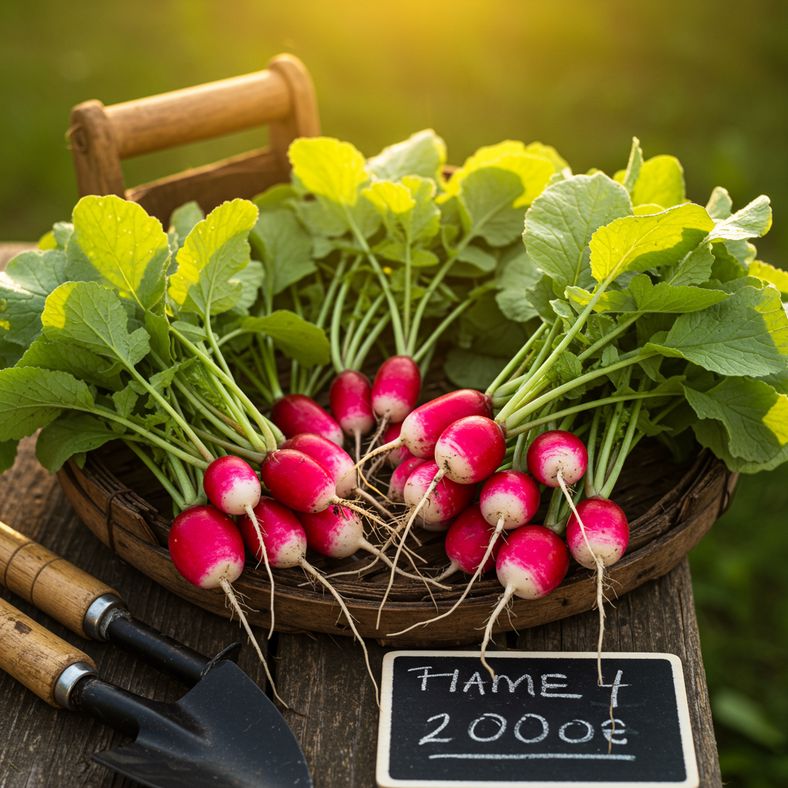
Timing your harvest correctly is crucial for July-sown radishes. The warm growing conditions mean the window between perfect ripeness and over-maturity is shorter than spring sowings.
Harvest Timing Indicators
Your radishes are ready when:
- Root diameter: Globe varieties reach 2-3cm diameter, cylindrical types are 1-2cm wide
- Visual cues: Shoulders of the root are visible above soil level
- Texture test: Gently squeeze – they should feel firm and solid
- Time elapsed: 18-30 days from sowing, depending on variety
July heat accelerates maturity, so begin checking your radishes 2-3 days before the expected harvest date.
Harvesting Technique
Harvest during the cooler parts of the day (early morning or evening) to maintain crispness:
- Grip the leaves close to the crown and pull straight up with a gentle twisting motion
- For larger varieties, loosen soil around the root with a hand fork first
- Harvest the entire crop within 2-3 days once the first radishes reach maturity
- Don't leave mature radishes in the ground – July heat quickly makes them woody and bitter
Post-Harvest Handling
To maintain quality and extend storage life:
- Remove leaves immediately after harvest to prevent moisture loss
- Wash roots gently in cool water to remove soil
- Store in the refrigerator in perforated plastic bags
- Use within 1-2 weeks for best flavour and texture
Succession Harvesting
If you've sown multiple rows or containers, harvest the earliest sowings first and continue in sequence. This approach provides continuous fresh radishes throughout late summer and early autumn.
For those planning to preserve their harvest, July radishes are excellent for pickling, adding to fermented vegetable mixes, or dehydrating for winter use.
Troubleshooting Common July Growing Issues
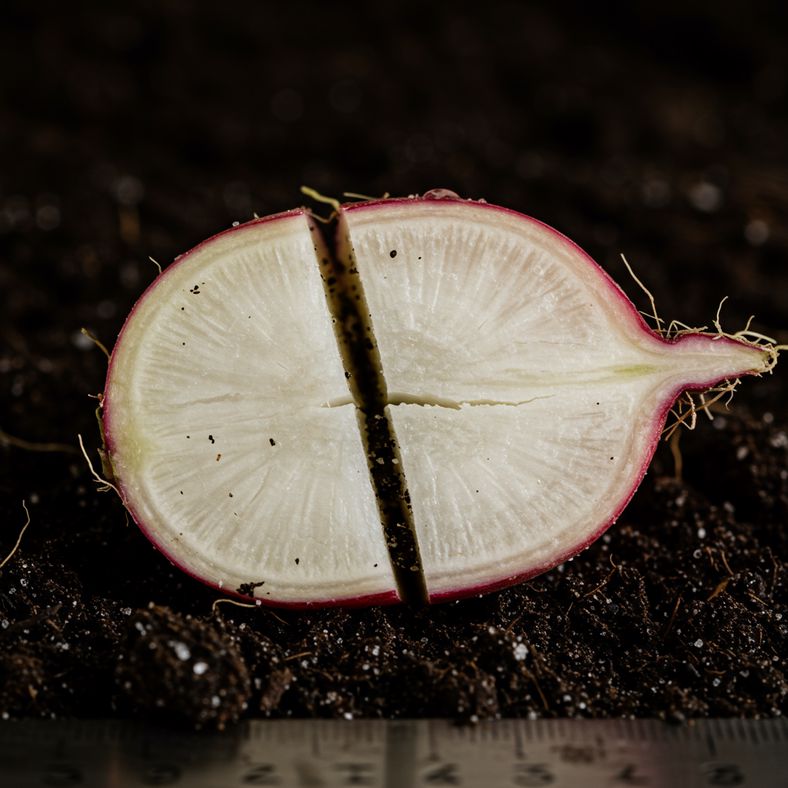
July's challenging growing conditions can lead to specific problems with radish crops. Understanding these issues and their solutions ensures successful harvests.
Bolting and Premature Flowering
Symptoms: Plants develop flower stalks before roots mature, making radishes inedible and bitter.
Causes: High temperatures, drought stress, or day length sensitivity
Solutions:
- Choose bolt-resistant varieties specifically bred for summer growing
- Maintain consistent soil moisture through regular watering
- Provide afternoon shade during heat waves
- Harvest promptly when roots reach maturity
- Plant in cooler microclimates within your garden
Woody or Pithy Roots
Symptoms: Radishes feel spongy when squeezed and have tough, fibrous flesh
Causes: Overmaturity, inconsistent watering, or excessive heat
Solutions:
- Harvest radishes promptly when they reach proper size
- Maintain consistent soil moisture levels
- Provide mulch to moderate soil temperature
- Choose varieties known for holding quality in heat
Poor Root Development
Symptoms: Roots fail to swell or remain small and thin
Causes: Overcrowding, poor soil conditions, or inadequate water
Solutions:
- Thin seedlings to proper spacing (3-4cm apart)
- Ensure soil is loose and well-draining
- Maintain consistent moisture without waterlogging
- Avoid high-nitrogen fertilizers that promote leaf growth over roots
Pest Management
Flea Beetles: These tiny jumping insects create small holes in leaves but rarely affect root development significantly. Use row covers or companion planting with nasturtiums to deter them.
Slugs and Snails: July's warm, humid conditions can increase slug activity. Use beer traps, copper barriers, or hand-picking in the evening.
Cabbage Root Fly: Less common in July but can affect longer-growing varieties. Use fine mesh covers or companion planting with alliums.
Disease Prevention
July's warm, humid conditions can promote fungal diseases:
- Improve air circulation: Avoid overcrowding and ensure proper spacing
- Water at soil level: Avoid wetting leaves to reduce disease risk
- Rotate crops: Don't plant brassicas in the same spot consecutively
- Remove debris: Clear away plant residues that can harbor diseases
Companion Planting and Succession Strategies

Maximizing your July radish harvest involves strategic companion planting and succession sowing techniques that work with summer growing conditions.
Ideal Companion Plants
July-sown radishes benefit from companions that provide shade, pest control, or complementary growth habits:
Lettuce and Spinach: These leafy greens provide natural shade for radish roots while benefiting from the radishes' soil-breaking action. Plant lettuce 2-3 weeks before radishes for optimal shading.
Nasturtiums: Act as a living mulch and trap crop for aphids and flea beetles. Their sprawling habit helps keep soil cool and moist around radish roots.
Chives and Garlic: These alliums help deter cabbage root fly and other brassica pests while taking up minimal space.
Carrots: Plant carrots between radish rows – the radishes will be harvested before carrots need the space, making efficient use of garden beds.
Succession Planting Schedule
For continuous harvests from July through September, follow this planting schedule:
- Early July (1st-7th): First sowing of Cherry Belle and Scarlet Globe
- Mid-July (10th-17th): Second sowing plus French Breakfast varieties
- Late July (20th-27th): Third sowing focusing on heat-tolerant varieties
- Early August (1st-7th): Final summer sowing of quick varieties
Each sowing should be small – enough for 1-2 weeks of fresh radishes for your household.
Intercropping Techniques
Row Intercropping: Plant radishes between rows of slower-growing crops like beans or peas. The radishes mature and are harvested before the main crop needs the space.
Vertical Intercropping: Use radishes as a ground cover beneath climbing crops like runner beans, providing living mulch that conserves soil moisture.
Temporal Intercropping: Sow radishes in beds designated for autumn brassicas – harvest the radishes before transplanting winter cabbages or Brussels sprouts.
Space-Efficient Growing
July's warm conditions make container growing particularly effective:
- Window boxes: Perfect for Cherry Belle and other compact varieties
- Raised beds: Provide better drainage and soil warming for faster growth
- Vertical planters: Use tower planters or hanging baskets for small varieties
- Succession containers: Start new containers every 2 weeks for continuous harvests
For organic growing success, consider supplementing with quality liquid fertilizer diluted to half strength for container-grown radishes.